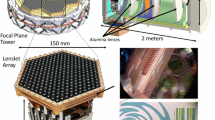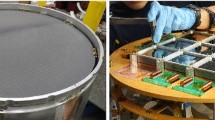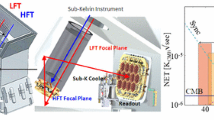Abstract
We present an overview of the design and development of the POLARBEAR-2 experiment. The POLARBEAR-2 experiment is a cosmic microwave background polarimetry experiment, which aims to characterize the small angular scale B-mode signal due to gravitational lensing and search for the large angular scale B-mode signal from inflationary gravitational waves. The experiment will have a 365 mm diameter multi-chroic focal plane filled with 7,588 polarization sensitive antenna-coupled Transition Edge Sensor bolometers and will observe at 95 and 150 GHz. The focal plane is cooled to 250 mK. The bolometers will be read-out by SQUIDs with \(32\times \) frequency domain multiplexing. The experiment will utilize high purity alumina lenses and thermal filters to achieve the required high optical throughput. A continuously rotating, cooled half-wave plate will be used to give stringent control over systematic errors. The experiment is designed to achieve a noise equivalent temperature of 5.7 \(\mu \)K\(\sqrt{s}\), and this allows us to constrain the signal from the inflationary primordial gravitational corresponding to a tensor-to-scalar ratio of \(r = 0.01\) (\(2\sigma \)). POLARBEAR-2 will also be able to put a constraint on the sum of neutrino masses to 90 meV (\(1\sigma \)) with POLARBEAR-2 data alone and 65 meV (\(1\sigma \)) when combined with the Planck satellite. We plan to start observations in 2014 in the Atacama Desert in Chile.




Similar content being viewed by others
References
J. Kovac et al., Detection of polarization in the cosmic microwave background using DASI. Nature 420, 772–787 (2002)
H. Wayne, Mass reconstruction with cmb polarization. Astrophys. J. 574, 566–574 (2002)
U. Seljak et al., Signature of gravity waves in the polarization of the microwave background. Phys. Rev. Lett. 78, 2054–2057 (1997)
J. Bock et al., Task force on cosmic microwave background research. 2006.
The POLARBEAR cosmic microwave background polarization experiment, J. Low Temp. Phys., 2013 Submitted.
Z.D. Kermish et al., The POLARBEAR experiment, in Proceedings of SPIE mm, sub-mm, and far-IR Detectors and Instr for Astro VI 2012, 2012, pp. 84521C–84521C-15
T. Tomaru et al., The POLARBEAR-2 experiment, in Proceedings of SPIE mm, sub-mm, and far-IR Detectors and Instr for Astro VI 2012, 2012, pp. 84521H–84521H-10
T. Matsumura et al., POLARBEAR-2 optical and polarimeter designs. Proceedings of SPIE mm, sub-mm, and far-IR Detectors and Instr for Astro VI 2012, 2012, pp. 84523E–84523E-8
Y. Inoue, The thermal design of the polarbear-2 experiment. Master’s thesis, The Graduate University for Advanced Studies, 2012
A. Suzuki et al., Multichroic dual-polarization bolometric detectors for studies of the cosmic microwave background. Proceedings of SPIE mm, sub-mm, and far-IR Detectors and Instr for Astro VI 2012, 2012, pp. 84523H–84523H-10
A. Suzuki et al., Multi-chroic dual-polarization bolometric detectors for studies of the cosmic microwave background. J. Low Temp. Phys., 2013 Submitted
T. Matsumura, A cosmic microwave background polarimeter using a superconducting magnetic bearing. PhD thesis, University of Minnesota, 2006
T. Matsumura, Performance of three- and five-stack achromatic half-wave plates at millimeter wavelengths. App. Opt. 48(19), 3614–3625 (2009)
R. O’Brient, A dual-polarized broadband planar antenna and channelizing filter bank for millimeter wavelengths. Appl. Phys. Lett. 102(6), 63506 (2013)
T. de Haan et al., Improved performance of tes bolometers using digital feedback. 2012, pp. 84520E–84520E-10
K. Hattori et al., Adaption of frequency-domain readout for transition edge sensor bolometers for the polarbear-2 cosmic microwave background experiment, in Proceedings for VCI2013, 2013
Acknowledgments
We acknowledge support from the MEXT Kahenhi grant 21111002, NSF grant AST-0618398, NASA grant NNG06GJ08G, The Simons Foundation, Natural Sciences and Engineering Research Council, Canadian Institute for Advanced Research and the CONICYT. Detectors were fabricated at Berkeley nanofabrication laboratory.
Author information
Authors and Affiliations
Corresponding author
Rights and permissions
About this article
Cite this article
Suzuki, A., Ade, P., Akiba, Y. et al. The POLARBEAR-2 Experiment. J Low Temp Phys 176, 719–725 (2014). https://doi.org/10.1007/s10909-014-1112-x
Received:
Accepted:
Published:
Issue Date:
DOI: https://doi.org/10.1007/s10909-014-1112-x




